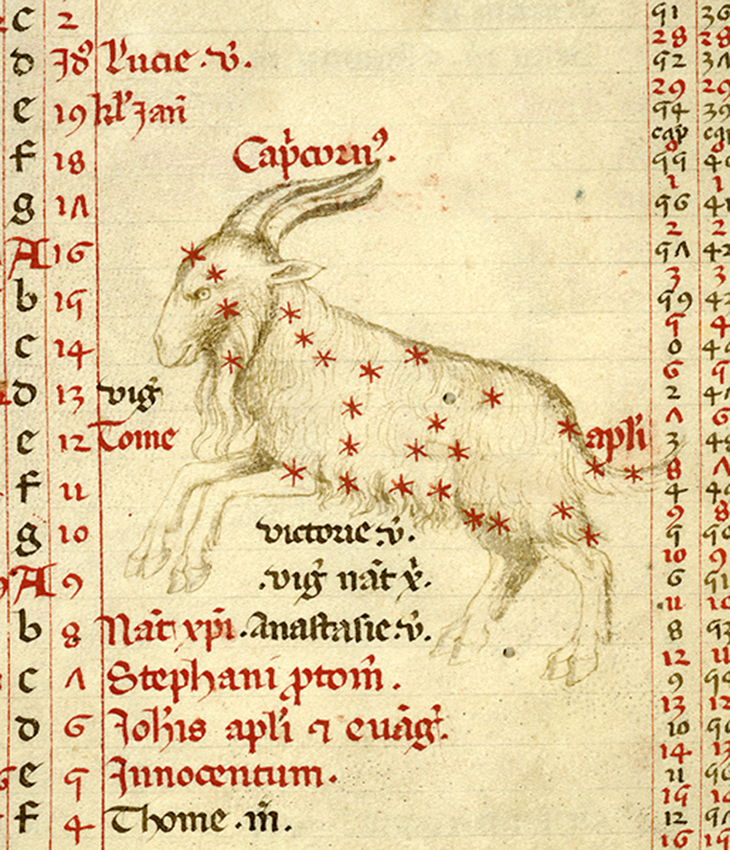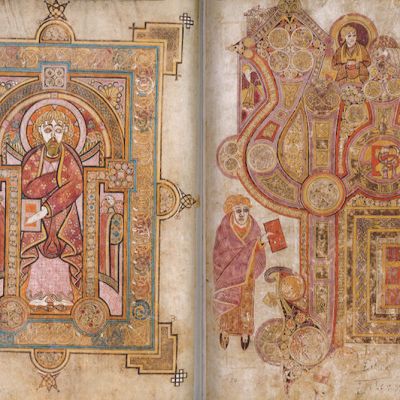When it came to time, Europeans in the Middle Ages were like Janus, always looking both backwards and forwards. Back to the seven days of creation and to the crucifixion of Christ, against which all the years are counted. Forwards to the Last Judgement and the very end of time, which throughout the medieval centuries was felt to be imminent. ‘Now and Forever: The Art of Medieval Time’ at the Morgan Library & Museum explores this twofold worldview and its surprising influence on our own patterns of life through a similarly bifurcated display of over 50 lavish medieval manuscripts.
The first half of the exhibition introduces medieval calendars and their uses, explaining the complex cycles of holy days that defined the medieval year, and describing some of the ways in which history and historical knowledge were understood and expressed. There are tiny Books of Hours that would fit snugly into the palm of your hand. There are three massive scrolls, one nearly 20 metres long, that digest vast quantities of historical information into compelling linear narratives. There are sumptuous psalters, their calendars illuminated with the signs of the zodiac and the labours of the months (represented through idealised vignettes of peasant labour and aristocratic leisure).
San Zeno Astrolabe (c. 1455), illuminated for the Abbey of San Zeno by an anonymous Lombard artist. Collection of Michael Stone. Courtesy of Map & Atlas Museum of La Jolla and Michael Stone

One especially luxurious calendar, from the Psalter-Hours of Guiluys de Boisleux, is written in red and blue on a silver page ruled with gold. Another book contains a kind of parchment computer, called a volvelle, the moving parts of which show the positions of the planets. On a grander scale, the San Zeno Astrolabe – both the only loan in the exhibition and the only surviving object of its kind – could help the monks who owned it keep track not only of the planets, but of the phases of the moon, hours of daylight, and the day’s saint as well.
Hell, Hours of Catherine of Cleves (c. 1440), illuminated for Catherine of Cleves, Duchess of Guelders, by the Master of Catherine of Cleves. The Morgan Library & Museum, New York. Photo: Graham Haber

The exhibition’s second half explores the preoccupation of medieval people with the prospect of their own deaths, and with what they could expect in the next life. A series of manuscripts lie open to show miniatures of funeral masses and hell-scapes. A highlight of this sequence is the exquisite Hours of Catherine of Cleves, which depicts brightly coloured devils throwing souls into the gaping jaws of hell by the cartload. These visceral fantasies illustrate the very real fears that drove people to seek papal indulgences. Three of these official documents granting time off from the pains of Purgatory, in exchange for a fee, are on display here.
Many medieval time-keeping practices are still in use today. The anno domini system we use to measure history was devised by a sixth-century monk; the modern tax year has its origins in the medieval English habit of counting the 25th of March, the Feast of the Annunciation, as the start of the new year. Even mechanical clocks with rotating hands were a medieval invention, first appearing around the year 1300. Despite this, many medieval time-keeping objects are initially indecipherable to a modern viewer. A calendar from the Middle Ages looks very little like a modern one (for one thing, the days of the month don’t tend to be numbered), and Arabic digits were only introduced in Europe in the 12th century, and didn’t supplant Roman numerals until much later. Over 15,000 saints were venerated, and their corresponding days marked, by late medieval Catholicism. (A result of this was that some feasts could be extremely local – one was celebrated only in the upper chamber of Paris’s Sainte Chapelle.) However, lucid wall texts and diagrams help make sense of the jumble of golden numbers, dominical letters, and red-letter days that shaped the medieval year, and a new book published to accompany the exhibition (The Medieval Calendar: Locating Time in the Middle Ages by Roger S. Wieck, who also curated the show) explores a selection of these themes in satisfying detail.
Liturgical calendar for Ravenna, Italy, Milan (1386), illustrated by a follower of Giovannino de’ Grassi. The Morgan Library & Museum, New York. Photo: Graham Haber

‘Now and Forever’ offers a feast for the eyes, making judicious use of the Morgan’s rich collections of manuscripts from the 12th to the 16th centuries. Some of the objects on display are incredibly rare, almost alien in their unfamiliarity. There is a fold-out girdle calendar made to be worn hanging from the belt, and an arcane runic calendar with pictorial riddles inscribed on pages made of bone. Yet others, with a little translation assistance, are uncannily recognisable, revealing how medieval concepts and practices continue to influence the way we think, talk about and keep time.
‘Now and Forever: The Art of Medieval Time’ is at the Morgan Library & Museum, New York, until 29 April.



